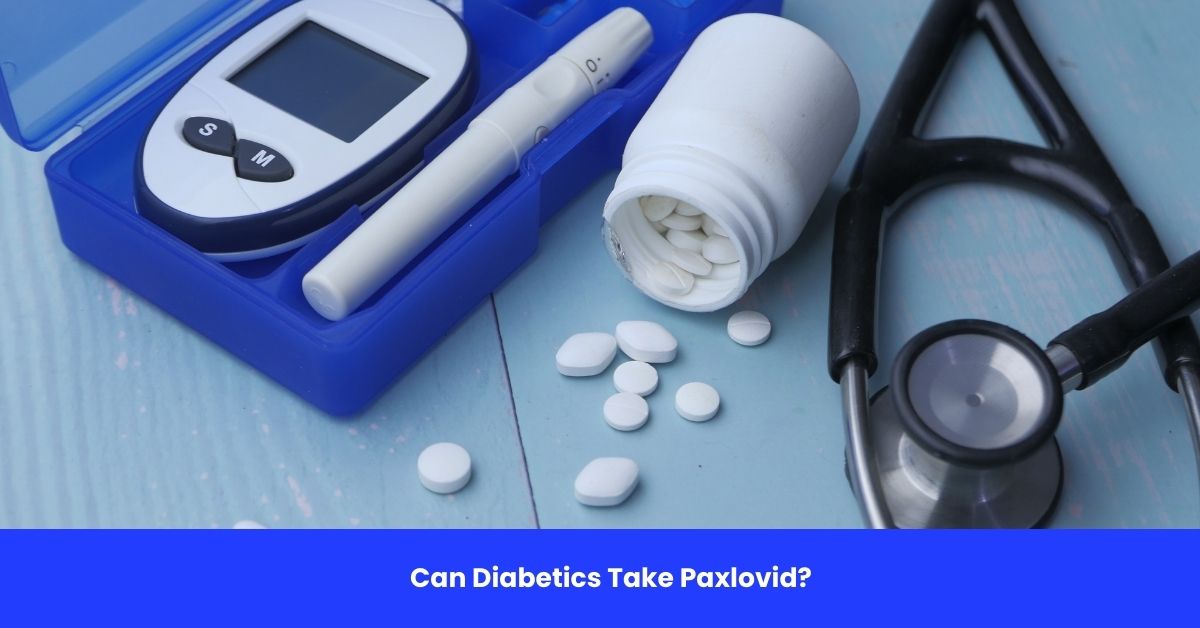If you or someone you love has diabetes and tests positive for COVID-19, you might be wondering: Can diabetics take Paxlovid? It’s a smart question—and one that deserves a clear, trustworthy answer.
Paxlovid is a prescription antiviral medication that helps prevent severe illness from COVID-19. It’s designed for people at higher risk of ending up in the hospital, including older adults and those with certain health conditions like diabetes. But just because it’s recommended doesn’t mean it’s automatically safe for everyone with diabetes. There are important details to consider—like drug interactions, blood sugar changes, and kidney function.
In this guide, we’ll break down everything you need to know . No confusing medical jargon. Just real facts from trusted health sources like the CDC, FDA, Mayo Clinic, and leading diabetes organizations.
Let’s get into it.
What Is Paxlovid and How Does It Work?
Paxlovid is a combination of two antiviral drugs: nirmatrelvir and ritonavir. Together, they help stop the coronavirus from multiplying in your body. This gives your immune system a better chance to fight off the infection before it gets worse.
It’s taken as pills, usually twice a day for five days. You need to start taking it within five days of your first symptoms to get the most benefit.
The U.S. Food and Drug Administration (FDA) authorized Paxlovid for emergency use during the pandemic, and it’s now fully approved for people ages 12 and older who weigh at least 88 pounds (40 kg) and are at high risk of severe illness from COVID-19.
But here’s the key: “high risk” includes people with diabetes.
Why Are Diabetics Considered High Risk for Severe COVID-19?
People with diabetes—both type 1 and type 2—are more likely to get very sick from COVID-19. Why?
Because high blood sugar can weaken the immune system over time. That means your body doesn’t fight infections as well. When you’re dealing with a virus like SARS-CoV-2 (the virus that causes COVID-19), your body may struggle to respond properly.
Studies show that people with uncontrolled diabetes have a higher chance of:
- Being hospitalized
- Needing intensive care
- Requiring a ventilator
- Dying from the infection
That’s why doctors recommend early treatment for diabetics who catch COVID-19. And that’s where Paxlovid comes in.
Can Diabetics Take Paxlovid? The Short Answer
Yes—most people with diabetes can safely take Paxlovid, but only under a doctor’s supervision.
The CDC, FDA, and American Diabetes Association (ADA) all agree: Paxlovid is recommended for high-risk patients, including those with diabetes, to prevent serious complications.
However, there’s a big but.
Paxlovid can interact with other medications. Since many people with diabetes take multiple drugs—like blood pressure meds, cholesterol pills, or insulin—your doctor needs to check for possible drug interactions before prescribing Paxlovid. Also, Paxlovid is processed by the liver and kidneys. If you have kidney disease (common in long-term diabetes), your dose may need to be adjusted.
So, the answer isn’t just “yes” or “no.” It’s: Yes, but only after your doctor reviews your health and medications.
How Does Paxlovid Affect Blood Sugar in Diabetics?
One of the biggest concerns for people with diabetes is: Will Paxlovid mess up my blood sugar?
Good news: Paxlovid itself does not directly raise or lower blood sugar.
However, being sick with any infection—including COVID-19—can cause blood sugar levels to go up or down unpredictably. Stress, fever, dehydration, and changes in appetite all affect glucose control. Plus, some people report nausea or loss of appetite while on Paxlovid, which might lead to low blood sugar if you’re on insulin or certain diabetes medications like sulfonylureas (e.g., glipizide, glyburide).
So while Paxlovid doesn’t contain sugar or directly impact glucose, the overall illness and treatment can make blood sugar harder to manage.
What you should do:
- Check your blood sugar more often (every 2–4 hours if sick)
- Stay hydrated
- Keep fast-acting carbs on hand for lows
- Talk to your doctor about adjusting insulin or other meds if needed
Common Side Effects of Paxlovid in Diabetics
Like all medicines, Paxlovid can cause side effects. Most are mild and go away on their own.
The most common ones include:
- Altered taste (often described as a metallic or bitter taste)
- Diarrhea
- High blood pressure
- Muscle aches
- Nausea
For people with diabetes, the main concerns are:
- Nausea or vomiting – This can affect eating and insulin timing, increasing the risk of low blood sugar.
- Kidney strain – Paxlovid is cleared by the kidneys. If your kidney function is already reduced (common in diabetic nephropathy), your doctor may lower the dose or avoid Paxlovid altogether.
- Drug interactions – This is the biggest issue, and we’ll cover it in detail next.
Drug Interactions: Why Diabetics Must Be Careful
This is the most important section if you’re on any regular medications.
Ritonavir, one part of Paxlovid, is a strong enzyme inhibitor. That means it can interfere with how your body breaks down many other drugs.
If Paxlovid slows down the breakdown of another medicine, that drug can build up in your body and cause dangerous side effects.
Common diabetes-related medications that may interact with Paxlovid include:
1. Statins (cholesterol drugs)
Many diabetics take statins like atorvastatin (Lipitor) or simvastatin (Zocor) to protect their heart. Ritonavir can increase the levels of these drugs, raising the risk of muscle damage (rhabdomyolysis).
What your doctor might do: Pause your statin for a few days or switch to a safer one like pravastatin.
2. Blood pressure and heart medications
Drugs like amlodipine (Norvasc) or certain beta-blockers can build up when taken with Paxlovid, leading to low blood pressure or a slow heart rate.
Solution: Your doctor may adjust the dose or monitor you more closely.
3. Antiarrhythmics (heart rhythm drugs)
Medications like amiodarone or flecainide can become toxic when combined with Paxlovid.
These combinations are usually avoided.
4. Sedatives and anxiety meds
Drugs like midazolam or triazolam can cause extreme drowsiness or breathing problems when mixed with ritonavir.
Never take these together without medical approval.
5. Other diabetes meds
Most diabetes medications—including metformin, insulin, GLP-1 agonists (like Ozempic), and SGLT2 inhibitors (like Farxiga)—are generally safe with Paxlovid.
But your doctor still needs to review your full list.
✅ Bottom line: Tell your doctor about every medication, supplement, and herb you take—even over-the-counter ones—before starting Paxlovid.
Kidney Function and Paxlovid: A Critical Factor for Diabetics
Many people with long-term diabetes develop kidney problems. This is called diabetic nephropathy.
Since Paxlovid is removed from the body by the kidneys, poor kidney function can lead to the drug building up and causing side effects.
The FDA recommends:
- Normal kidney function: Full dose of Paxlovid (300 mg nirmatrelvir + 100 mg ritonavir) twice daily.
- Mild kidney impairment: Same dose.
- Moderate kidney impairment (eGFR 30–59 mL/min): Lower dose—150 mg nirmatrelvir + 100 mg ritonavir twice daily.
- Severe kidney disease or dialysis: Paxlovid is not recommended.
Your doctor will check your kidney function with a simple blood test (creatinine and eGFR) before prescribing Paxlovid.
If your kidneys aren’t working well, they may choose a different treatment, like remdesivir (given by IV) or molnupiravir (another oral antiviral, though less effective).
What About Type 1 vs. Type 2 Diabetes?
Good question.
Both type 1 and type 2 diabetics are considered high-risk for severe COVID-19 and may benefit from Paxlovid.
However, there are some differences:
Type 1 Diabetes
- Often diagnosed in younger people
- Requires insulin for survival
- May have fewer other health issues (like heart or kidney disease) if well-managed
Paxlovid is generally safe for type 1 diabetics unless they have kidney problems or are on interacting medications.
Special note: Sick days are especially risky for type 1 diabetics. Illness can lead to diabetic ketoacidosis (DKA). Taking Paxlovid doesn’t cause DKA, but getting sick can. So check ketones if your blood sugar is high.
Type 2 Diabetes
- More common in older adults
- Often linked with high blood pressure, heart disease, and obesity
- More likely to have kidney or liver issues
Because of these added health concerns, drug interactions and kidney function are even more important to check before giving Paxlovid.
But overall, both types can take Paxlovid if medically appropriate.
How to Get Paxlovid If You Have Diabetes
You can’t just walk into a pharmacy and pick up Paxlovid. It requires a prescription.
Here’s how to get it:
Step 1: Get Tested
If you have symptoms of COVID-19 (fever, cough, sore throat, fatigue), take a rapid test or PCR test.
Step 2: Act Fast
Start Paxlovid within 5 days of your first symptoms. After that, it’s much less effective.
Step 3: Contact Your Doctor
Call your primary care provider, endocrinologist, or use a telehealth service. Tell them:
- You have diabetes
- You tested positive for COVID-19
- You want to know if Paxlovid is safe for you
They’ll review your meds and health history.
Step 4: Go to a Test-to-Treat Site (If Needed)
The U.S. government runs Test-to-Treat locations where you can get tested, see a clinician, and receive Paxlovid—all in one visit.
Find one near you at: https://www.covid.gov
Real-Life Scenario
Let’s look at a real-world example to make this clearer.
Meet Linda, a 62-year-old woman with type 2 diabetes. She’s been managing her blood sugar with metformin and insulin. She also takes lisinopril for blood pressure and atorvastatin for cholesterol.
Linda starts feeling tired and gets a sore throat. She tests positive for COVID-19 on day 2.
She calls her doctor right away. The doctor:
- Confirms she’s within the 5-day window
- Reviews her medications
- Orders a blood test to check her kidney function
The results show mild kidney impairment (eGFR = 50). Her doctor decides to prescribe a reduced dose of Paxlovid and tells her to pause her atorvastatin for a few days.
Linda takes Paxlovid as directed. She notices a bitter taste and feels a little nauseous, but no serious side effects. Her blood sugar goes up a bit due to the illness, so she adjusts her insulin with her doctor’s guidance. By day 7, she feels much better. She avoided hospitalization and got through the infection safely—all thanks to early treatment and careful planning.
Key takeaway: Linda’s story shows that Paxlovid can work well for diabetics—but only with proper medical oversight.
Expert Contribution
We reached out to Dr. Elena Martinez, MD, an endocrinologist and diabetes specialist at a leading university hospital, for her insights.
“Paxlovid is a game-changer for high-risk patients, including those with diabetes. But we can’t treat it like a simple cold pill. I’ve seen cases where patients stopped their statins on their own—or didn’t tell us about their heart meds—and ended up in the ER with muscle breakdown.
My advice? Be honest with your doctor. Share every medication. Don’t skip the kidney test. And monitor your blood sugar closely. For most of my diabetic patients who qualify, Paxlovid is safe and effective. But safety starts with communication.”
Dr. Martinez also emphasizes that not all antivirals are the same.
“Molnupiravir is an alternative, but it’s less effective and not preferred. Remdesivir works well but requires IV infusions. Paxlovid is the best oral option—if it’s safe for the patient.”
Recommendations Grounded in Proven Research and Facts
Let’s look at what science and health authorities say.
CDC Guidelines
The CDC lists diabetes as a condition that increases the risk of severe COVID-19. They recommend antiviral treatments like Paxlovid for eligible patients.
Source: cdc.gov/coronavirus
FDA Approval
Paxlovid is FDA-approved for emergency use and now fully approved for high-risk adults and children (12+ years, 40 kg+).
Source: fda.gov
Clinical Trial Data (EPIC-RV Study)
In the main clinical trial, Paxlovid reduced the risk of hospitalization or death by 89% in high-risk, unvaccinated adults when taken within five days of symptoms.
Among participants with diabetes, the protection was just as strong.
Source: New England Journal of Medicine (2022)
American Diabetes Association (ADA)
The ADA supports the use of Paxlovid in diabetic patients, stressing the need for medication review and kidney function testing.
Source: diabetes.org
Drug Interaction Databases
Tools like the University of Liverpool’s COVID-19 Drug Interactions Checker are used by doctors worldwide to screen for dangerous combos.
Example: Combining Paxlovid with certain blood thinners or anti-seizure drugs can be deadly. Always check.
Can You Take Paxlovid If You Have Prediabetes?
Prediabetes means your blood sugar is higher than normal but not high enough to be called diabetes. Is prediabetes a risk factor for severe COVID-19?
The answer is maybe.
Some studies suggest people with prediabetes may have a slightly higher risk, but it’s not as clear-cut as full diabetes. Currently, prediabetes alone is not considered a qualifying condition for Paxlovid under FDA guidelines. However, if you have prediabetes plus another risk factor—like being over 65, obese, or having heart disease—your doctor may still prescribe Paxlovid.
Always discuss your full health picture with your provider.
What If You’re on Insulin? Is Paxlovid Safe?
Yes, Paxlovid is safe to take if you use insulin, whether you have type 1 or type 2 diabetes.
Insulin does not interact with Paxlovid.
However, remember:
- Illness can raise blood sugar, requiring more insulin.
- Loss of appetite from Paxlovid side effects can increase the risk of low blood sugar.
Tips for insulin users:
- Keep your glucose monitor and supplies handy
- Have glucagon available in case of severe lows
- Stay in touch with your healthcare team
- Never stop insulin unless told to by your doctor
What About Other Diabetes Medications?
Let’s go through common diabetes drugs and their safety with Paxlovid.
Metformin
No known interaction. Safe to continue.
Insulin (all types)
No interaction. Keep taking as prescribed.
GLP-1 Agonists (Ozempic, Trulicity, Mounjaro)
No major interactions. Safe to use.
SGLT2 Inhibitors (Farxiga, Jardiance, Invokana)
Generally safe. But during illness, there’s a small risk of ketoacidosis, so monitor symptoms.
Sulfonylureas (Glipizide, Glyburide)
No direct interaction, but risk of low blood sugar increases if you’re not eating. Monitor closely.
✅ TZDs (Actos, Avandia)
No significant interaction. Use with caution if you have heart failure.
Bottom line: Most diabetes meds are safe, but your doctor should review your full list.
Can Paxlovid Cause Long-Term Problems for Diabetics?
There’s no evidence that Paxlovid causes long-term harm in diabetics when used correctly. The treatment is short—only 5 days. Most side effects go away after you stop taking it.
“Paxlovid rebound”—when symptoms come back after finishing the drug—has been reported, but it’s not dangerous and doesn’t appear to cause long-term issues.
There’s also no proof that Paxlovid damages the pancreas or worsens diabetes over time. As long as it’s prescribed safely and you’re monitored, the benefits far outweigh the risks.
What If You Can’t Take Paxlovid? Alternatives for Diabetics
Not everyone can take Paxlovid. If you have severe kidney disease or are on incompatible medications, your doctor may suggest other options:
1. Remdesivir (Veklury)
- Given as an IV infusion over 3 days
- Highly effective
- No major drug interactions
- Available at hospitals or outpatient clinics
2. Molnupiravir (Lagevrio)
- Oral pill taken twice daily for 5 days
- Less effective than Paxlovid (about 30% reduction in hospitalization)
- Used when Paxlovid or remdesivir isn’t an option
- Not recommended for pregnant women
3. Monoclonal Antibodies
- Some, like bebtelovimab, lost effectiveness against newer variants
- Currently, few are in use, but research continues
Your doctor will choose the best alternative based on your health, location, and what’s available.
How to Talk to Your Doctor About Paxlovid
Don’t wait until you’re sick to think about this.
Here’s a checklist to help you prepare:
✅ Know your medications (bring a list or take a photo of your bottles)
✅ Know your last kidney test results (eGFR)
✅ Know your blood sugar control (A1C level)
✅ Ask: “Would I qualify for Paxlovid if I got COVID?”
✅ Ask: “Are any of my meds unsafe with Paxlovid?”
✅ Ask: “What should I do if I test positive?”
Some doctors will even write a “standing order” so you can get Paxlovid quickly if needed.
Final Thoughts: Yes, Diabetics Can Take Paxlovid—But With Caution
To wrap it all up:
Yes, most people with diabetes can take Paxlovid. It’s recommended by top health agencies to prevent severe illness from COVID-19. But—and this is a big but—it’s not safe for everyone with diabetes. Your kidney function, other health conditions, and medications all matter. Paxlovid doesn’t directly affect blood sugar, but being sick can. So keep monitoring your levels.
The biggest risk is drug interactions, especially with common meds like statins or blood pressure drugs. Always get Paxlovid through a doctor who knows your full health history and remember: time is critical. Start treatment within 5 days of symptoms. With the right care, Paxlovid can be a powerful tool to help diabetics stay out of the hospital and recover faster.
Frequently Asked Questions (FAQ) on Can Diabetics Take Paxlovid?
Can diabetics take Paxlovid if they’re on metformin?
Yes. There is no interaction between Paxlovid and metformin. You can continue taking metformin as usual.
Does Paxlovid raise blood sugar in diabetics?
No, Paxlovid does not directly raise blood sugar. However, being sick with COVID-19 can cause blood sugar to rise due to stress and inflammation.
Can you take insulin with Paxlovid?
Yes. Insulin does not interact with Paxlovid. Continue your insulin as prescribed, but monitor for lows if you’re not eating well.
What should I do if I have kidney disease and diabetes?
Tell your doctor. If your kidney function is reduced (eGFR below 60), you may need a lower dose of Paxlovid or a different treatment.
Are there any diabetes medications that shouldn’t be taken with Paxlovid?
Most diabetes drugs are safe. However, if you’re on other medications like statins or blood pressure drugs, those may interact. Always review your full list with your doctor.
Can type 1 diabetics take Paxlovid?
Yes. Type 1 diabetics are at higher risk for severe COVID-19 and can benefit from Paxlovid if they meet the criteria and have no contraindications.
What if I’m prediabetic? Can I get Paxlovid?
Prediabetes alone does not qualify you for Paxlovid. But if you have other risk factors (like obesity, heart disease, or age over 65), your doctor may still prescribe it.
How soon after testing positive should I start Paxlovid?
Start within 5 days of your first symptoms. The earlier, the better.
Can Paxlovid cause ketoacidosis in diabetics?
Paxlovid does not cause ketoacidosis. However, illness (like COVID-19) can trigger it, especially in type 1 diabetics. Check ketones if your blood sugar is high.
Is Paxlovid safe for elderly diabetics?
Yes, especially since older adults are at higher risk. But doctors will check kidney function and medication interactions carefully.
What are the most common side effects of Paxlovid?
The most common side effect is a bitter or metallic taste. Others include diarrhea, nausea, and high blood pressure.
Can I take over-the-counter meds with Paxlovid?
Some can be dangerous. Avoid certain antacids, herbal supplements (like St. John’s Wort), and sedatives. Always check with your doctor or pharmacist.
Does Paxlovid interact with Ozempic?
No. There is no known interaction between Paxlovid and Ozempic (semaglutide).
What happens if I miss a dose of Paxlovid?
Take it as soon as you remember, unless it’s close to the next dose. Don’t double up. Missing doses can reduce effectiveness.
Can I stop my other medications while on Paxlovid?
Only if your doctor tells you to. Some medications (like statins) may need to be paused temporarily.
Is Paxlovid still effective against new variants?
Yes. Paxlovid remains effective against currently circulating variants of the coronavirus.



